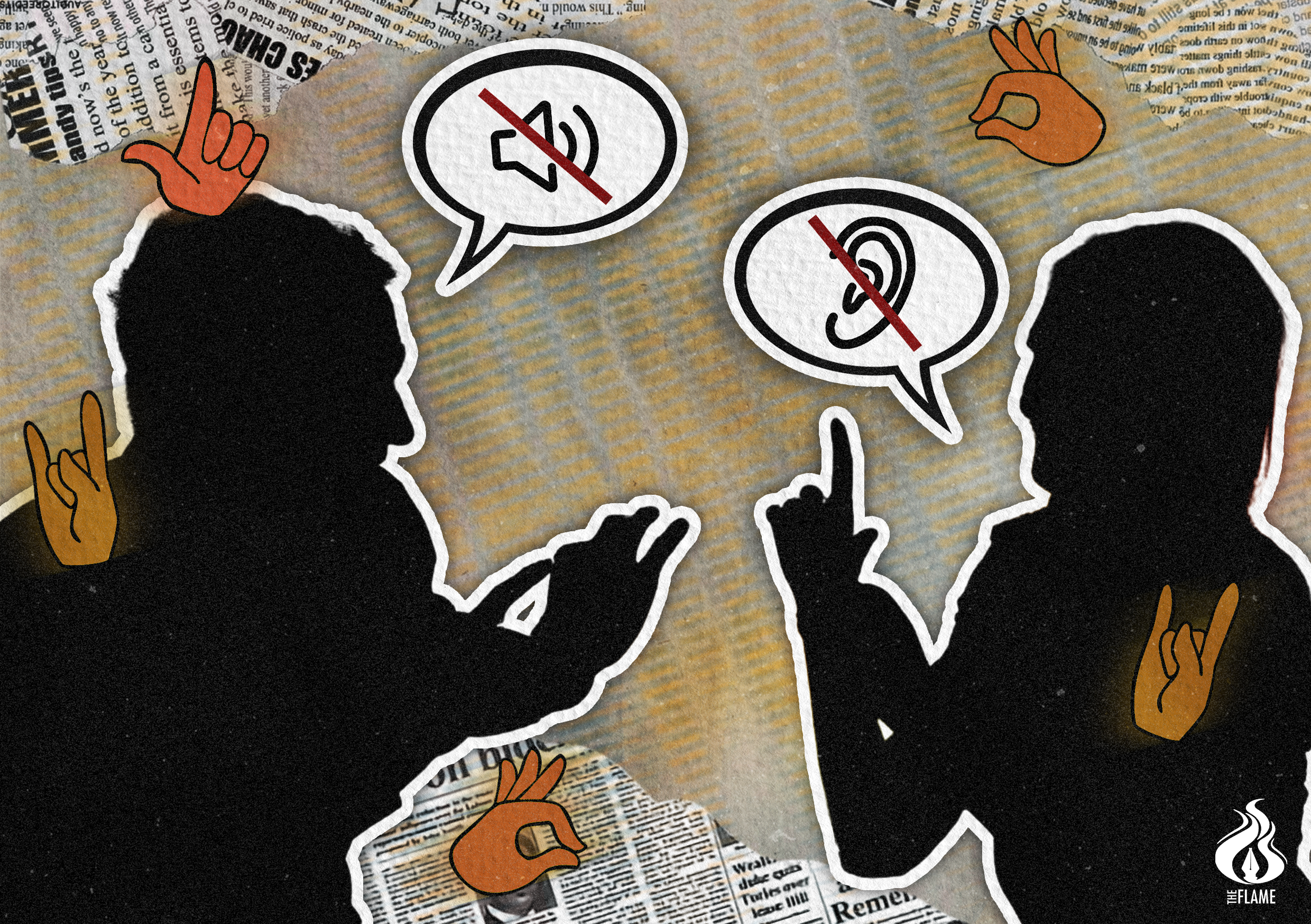
BECAUSE OF his hearing impairment, 30-year-old Aldian Aca-ac found it difficult to move about and to speak clearly during his younger years.
Despite his physical disability, he is striving to provide for his needs and has been working since he graduated in college. He started as a massage therapist in a salon and is now working at Hisbeans Cafe, a Korean cafe that employs persons with disabilities (PWDs).
Aca-ac recalled struggling to communicate with customers and growing his hair to hide his crooker ears to avoid being mocked.
“Dati tinatakpan [tenga] ko pa (I used to cover my ears),” Aca-ac, who has been working for four years, told The Flame.
“Naglakas loob na lang ako na i-cut tapos pakita sa mga tao na kaya ko rin yung kaya nila (I had the courage to cut my hair and show the people that I can also do what they are doing).”
Now confident that he can overcome his fears and limitations, Aca-ac decided to learn more about his disability and study sign language.
Fortunately for Aca-ac, Republic Act No. 11106 or the Filipino Sign Language Act was enacted in 2018 to improve the PWD community’s access to information. The law declares the Filipino sign language as the national sign language of the Filipino deaf and the official sign language of the government in all transactions involving them.
It also requires the use of the Filipino sign language in schools, broadcast media and workplaces. Agencies and local governments are also expected to consult with experts to propagate sign language competency among hearing people by offering Filipino sign language as an elective in the regular or mainstream curriculum.
But despite the passage of the sign language law, some groups believe the prevailing environment is not yet that inclusive for PWDs and that more should be done to improve their plight.
Difficulties
According to a report released in 2020 by the University of Santo Tomas (UST) Faculty of Medicine and Surgery, 15% of Filipinos experience moderate or worse hearing loss. While the percentage represents a significant number in the country’s more than 100 million population, not so many people know how to speak their language.
According to Marjorie Ramilo, president of Guild of Thomasian Speducators (GuTS), the deaf community still faces various challenges despite the enactment of the law seeking to promote the use of Filipino sign language. GuTS is a recognized student organization in UST that promotes the welfare of education students with special needs.
“It is still difficult to get the rest of the nation to embrace and comprehend FSL (Filipino sign language) despite the language’s continued evolution and the prevalence of its use among Filipino deaf people,” Ramilo said.
Because of this gap, some PWDs still do not feel that they belong to their respective communities. Aca-ac shared that some of his PWD friends are struggling to communicate effectively with their customers and could not stand up for themselves.
“I try to motivate them because I experienced that before. I have to share to them how I became courageous so they succeed,” he said.
“Kayang-kaya namin ‘yung mga gawain ng walang kapansanan… Sabi ko sa inyo, huwag kayong mahiya (We can also do the things being done by people without disabilities. I told them they should not be ashamed).”
UST Faculty of Arts and Letters Assistant Dean and history professor Melanie Turingan said the problem stems from the lack of awareness of the importance of inclusivity.
“The difficulty at the moment is the understanding of people with regard to the Filipino Sign Language. Well, not all Filipinos have this so-called idea of inclusivity and what being inclusive is all about,” Turingan told The Flame.
Bridging the gap
Aca-ac, who has worked in different jobs, believes it is crucial for everyone to know sign language given that not all establishments offer a PWD-friendly environment. He first learned sign language during his high school years when he asked the principal for a sign language class enrollment in his school.
Aside from his hearing impairment, Aca-ac was motivated to learn sign language because of people with similar or worse degrees of disability. He noted that the PWDs’ inability to communicate prevents them from raising their concerns and expressing their views.
“I said I would teach myself sign language so I can share my knowledge to them (fellow PWDs) and they will have a voice,” Aca-ac said.
Despite the efforts of Aca-ac and some groups to propagate the Filipino sign language, communication barriers still exist, making it difficult for some to relate to the condition of PWDs.
“Some people mock our deaf friends when (they are using sign language) because they are not knowledgeable enough on how to use sign language,” Ramilo explained.
The problem was placed on a spotlight a few years ago when a Malacañang official and a blogger were sued for supposedly disrespecting those who are using sign language.
In 2018, the Philippine Federation of the Deaf filed a complaint before the Ombudsman against then presidential communications assistant secretary Mocha Uson and blogger Drew Olivar for uploading a video that allegedly insulted those with hearing impairment.
The video, which was posted on Uson’s blog, showed Olivar “inventing” hand movements, an act described by the group as “vulgar” and a “very dangerous public example for hearing people.” According to the group, Uson and Olivar were “laughing and making fun” of the deaf.
The Philippine Deaf Resource Center also filed a complaint against Uson, accusing her of violating the Code of Conduct and Ethical Standards for Public Officials, the Civil Code of the Philippines, the Cybercrime Prevention Act, the Magna Carta for Persons with Disability, and the United Nations Convention on the Rights of Persons with Disabilities.
Uson and Olivar have apologized for the video but PWD advocates refused to accept the apology.
Limited access
While Uson and Olivar have learned their lesson the hard way, the controversial incident may not be the last time people with limited or no knowledge of sign language will mock PWDs.
Access to learning the country’s sign language is still limited as only a few schools and universities offer classes devoted to it. As of 2000, only 131 schools have been listed as special education centers, according to data from the Department of Education. However, not all of these institutions offer programs that cater to deaf students.
Some school curricula are also still not tailored fit for PWD learners since there are few interpreters in the workplace where deaf clients and workers reside, according to UST Department of Filipino professor Jamil Carvajal.
“Only a few of us are pushing for it (sign language interpreters in the workplace) and are knowledgeable of sign language,” Carvajal told The Flame.
Building an inclusive environment
To make information accessible to PWDs, the Komisyon sa Wikang Filipino introduced its Filipino sign language unit in July 2022 as part of the celebration of the Buwan ng Wika or language month.
UST has launched various programs in Rehabilitation Science and College of Education to help address the gap and make the Filipino sign language more inclusive.
“The University is one with the students, academic staff and support staff with these kinds of needs since we also have an office that caters to them,” Turingan said.
To create a more inclusive language for the PWD community, Carvajal said there should be sign language interpreters in work places.
“However, there is only a small workforce or manpower for sign language interpreting,” he added.
But one does not need to be an expert to help improve the conditions of differently abled people. Aca-ac said spreading awareness about the experiences of PWDs through social media would help amplify their voices and make the Filipino sign language more inclusive.
“Kayo yung tulay namin para maibahagi sa iba ‘yong naging experience namin (You serve as the bridge that will allow us to share our experiences),” he said. F – Pauline Nicole Bautista and Julianne Loreign Vicente



